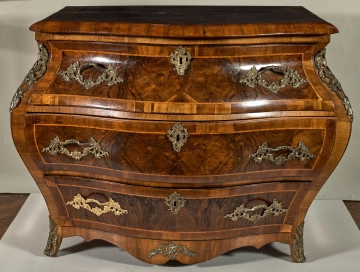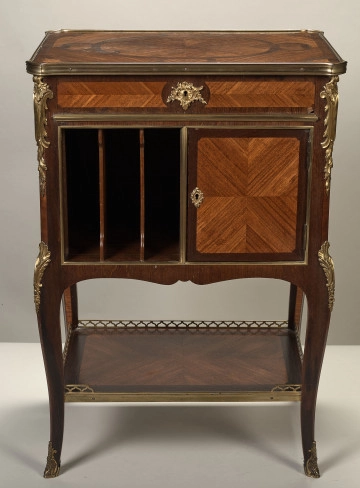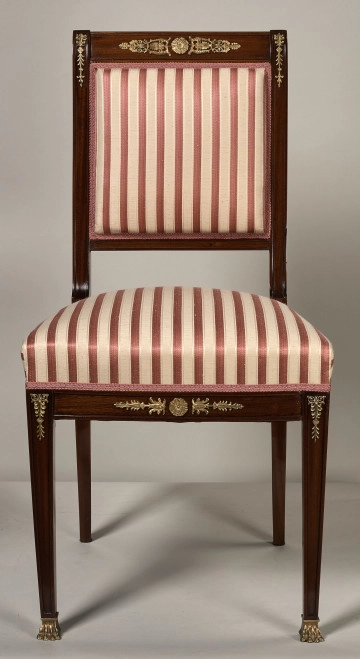
A la tombeau
18th century
Castle Museum in Łańcut
Part of the collection: Meble i wyposażenie wnętrz
One piece of furniture, used in France since the mid-18th century, is the chiffonier. It is a small, narrow, high chest of drawers used for storing undergarments, small ornaments, women’s clothing accessories, fabrics, personal items, papers, and jewellery. Its name comes from the French chiffon meaning canvas, a small piece of cloth, a rag. The presented classicist chiffonier was made together with another identical piece of furniture (S.7791MŁ; S.7792MŁ). According to the previous owners, the two chests of drawers, purchased by the Castle Museum in 1960, came from the Petit Trianon palace in the gardens of Versailles, which was a favourite of Queen Marie Antoinette. The white marble plaques on the front of each drawer of the mahogany veneered piece of furniture are eye-catching. Two smaller circular plaques serve as the background for the bronze cast handles. The central oval ones form the background for medallions with portrait busts. The reliefs, imitating ancient cameos, were made and signed by the English firm of Wedgwood & Bentley, operating between 1769 and 1780, at the Etruria factory in the Stoke-on-Trent area of central England. Thanks to Josiah Wedgwood’s experiments, the production of stoneware coloured with metal oxides and not requiring glazing, known as jasper stoneware, began in the 1870s. These were products with a light-coloured mass forming the background for the white relief art. The author of the white and blue medallions mounted on the chiffonier is John Flaxman, a modeller working for Josiah Wedgwood between 1775 and 1787. The medallions depict, in left profile: the writer, poet and philosopher Bernard le Bovier de Fontenelle; the mathematician and philosopher Jean le Rond d’Alembert; the artist, scientist and inventor Leonardo da Vinci. The fourth medallion is almost a twin to the Fontenelle image and may be a repetition or similarly shaped portrait of another unidentified person. Teresa Bagińska-Żurawska https://orcid.org/0000-0002-9243-3967
Author / creator
Dimensions
height: 93 cm, width: 47 cm
Object type
Furniture and interior fittings
Technique
inlaying, carpentry
Material
bronze, wood, biscuit
Creation time / dating
Creation / finding place
Owner
Castle Museum in Łańcut
Identification number
Location / status

unknown
18th century
Castle Museum in Łańcut

Durand, Gervais Maximilien Eugène
18th century
Castle Museum in Łańcut

unknown
1st half of the 20th century
Castle Museum in Łańcut
DISCOVER this TOPIC
Museum of King Jan III's Palace at Wilanów
DISCOVER this PATH
Educational path
0/500

We use cookies to make it easier for you to use our website and for statistical purposes. You can manage cookies by changing the settings of your web browser. More information in the Privacy Policy.
We use cookies to make it easier for you to use our website and for statistical purposes. You can manage cookies by changing the settings of your web browser. More information in the Privacy Policy.
Manage cookies:
This type of cookies is necessary for the website to function. You can change your browser settings to block them, but then the website will not work properly.
WYMAGANE
They are used to measure user engagement and generate statistics about the website to better understand how it is used. If you block this type of cookies, we will not be able to collect information about the use of the website and we will not be able to monitor its performance.